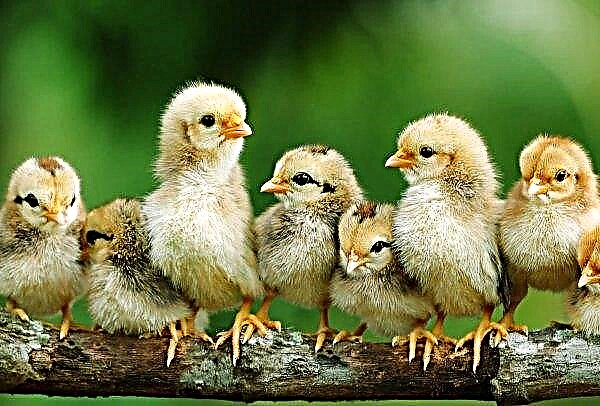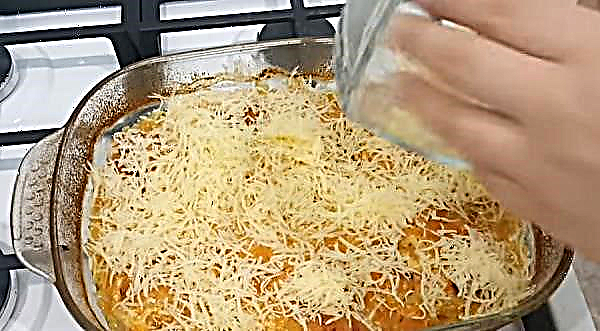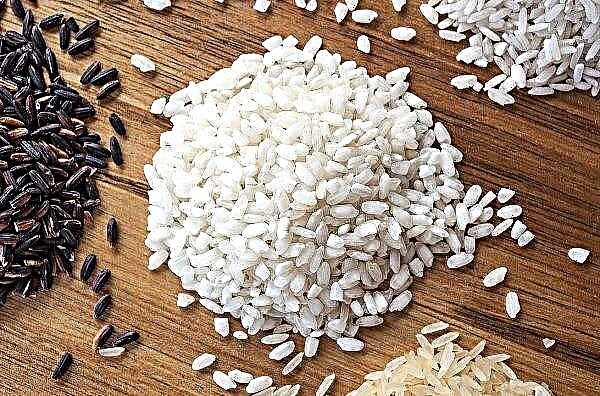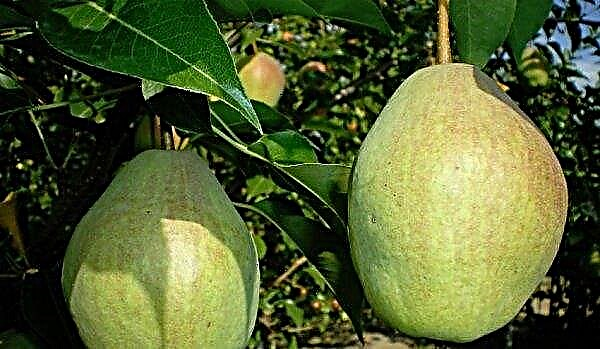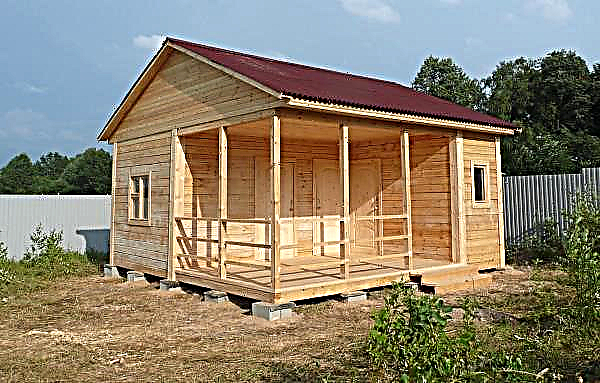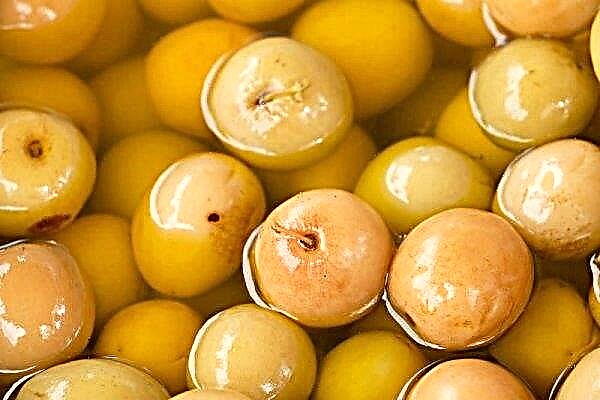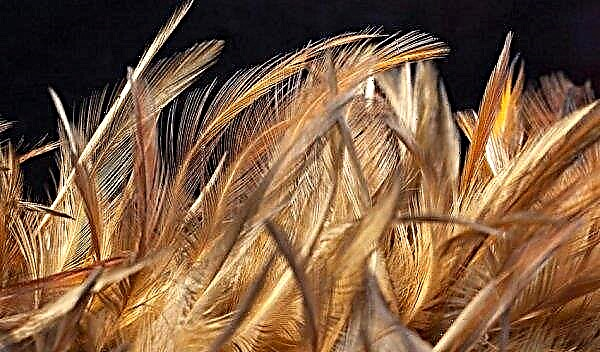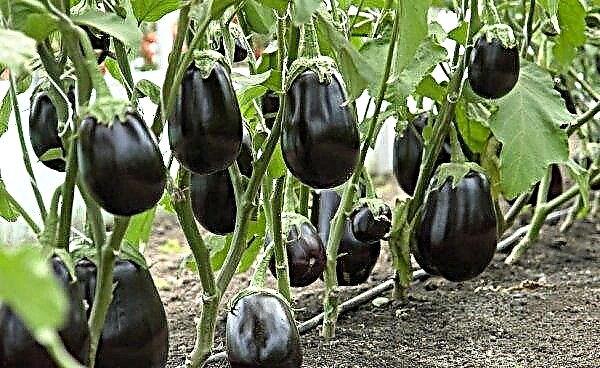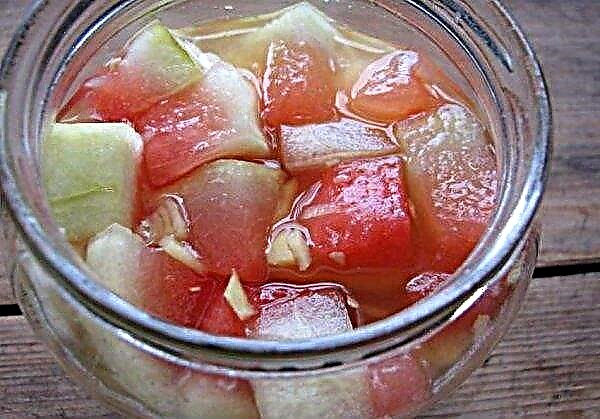Quite often in the garden plots of experienced gardeners or in parks you can find cedar pine. It is characterized by a lush crown, which gives an exotic appearance. The European variety is universal and highly resistant to frost, so it can be planted throughout Europe. This article will cover the basic rules for planting and caring for this crop.
View description
Cedar European pine has an external resemblance to the Siberian variety. The difference lies in the length of the needles, which reaches 9 cm. The needles are collected in a bundle of 5-6 pieces. in each. The shade of the needles is green-blue. The crown of the tree is ovoid, which extends downward.
Did you know? To collect 1 kg of pine nuts, you need at least 4 thousand seeds.
The height of the trunk is 25 m. The diameter of the crown is about 2 m. Young trees are smooth and slender. Over time, they become deformed, acquiring chaotic forms. Round cones are formed on the pine, whose length is about 8 cm. In diameter, they reach 7 cm.
 Cones are distributed throughout the area of the tree. Inside these "fruits" there are small seeds - pine nuts. In diameter, they reach 7–10 mm
Cones are distributed throughout the area of the tree. Inside these "fruits" there are small seeds - pine nuts. In diameter, they reach 7–10 mm
The trunk is covered with gray-brown bark, over the entire area of which there are small grooves. 3-4 years after planting, the tree changes the shade of the bark to light brown or red.
 Flowering takes place in late May or early June
Flowering takes place in late May or early June
Common varieties
There are a huge number of varieties of Pinus Cembra. All of them externally have some similarities and differ only in small features.
Did you know? The cedar was first mentioned in the Bible. It was from the wood of this plant that Noah's Ark was created.
Features of the Aurea variety are as follows:
- crown conical shape;
- shade of needles - green, with a slight yellowish tint;
- tree height - 8–10 cm;
- crown diameter - up to 2 m;
- needles length - 9 cm;
- cones are dark brown in color. Their length is within 5–8 cm.

View Viridis characterized by ovoid crown shape. The needles, which are about 10 cm long, have a rich green hue. A tree can reach a height of 4 m. Cones of medium length (up to 5 cm) are characterized by a gray-brown color.

A variety of Verigata (Variega) is characterized by the following features:
- the shape of the crown is umbrella-shaped;
- needles - yellowish-golden;
- tree height - up to 10 m;
- the size of the needles is about 12 cm;
- light brown cones reach 5 cm in length. They are formed together in 2-3 pieces. in a bunch.

Klauka Compact variety refers to dwarf varieties. The height of the tree does not exceed 1 m, and the diameter of the pyramidal shape reaches 60 cm. The needles of blue color grow up to 9 cm in length. Ovoid cones reach a size of 7 cm.

Pygmy variety also considered dwarf. The tree does not grow above 1.2 m. The wide-pyramidal shape can reach 60–70 cm in diameter. The needles, which are 6 cm long, are characterized by a yellow-green hue. Cones are ovoid in shape and grow up to 5 cm in length.

Variety of European Cedar Pine Columnaris characterized by an active growth rate. The height of the tree reaches 12 cm, and the width of the columnar crown is about 1.5 m. The length of the bluish-green needles is 4 cm. Cones that have a gray-brown hue grow up to 5 cm in length.

Selection of seedlings
If you want to choose healthy and intact plants, then it is better to purchase them in specialized nurseries. In such institutions, during planting, trees are treated with special attention, so their root system is not damaged. If the seedling was not grown in a pot, but in the soil, then its root system should be in an earthen coma. Inspect the plant roots carefully. They should not have signs of disease (spots, cracks, etc.).
When choosing a seedling, you need to consider its size and age. The optimum plant height is not more than 3 m. The minimum size is 40 cm. To grow a beautiful tree, you need to choose a seedling whose age is no more than 3 years, otherwise it will be difficult to take root and will develop for a long time.

Phased landing
Saplings from pots in the open ground can be replanted from March to November. When planning a plot, consider the size of the seedlings. The optimal distance between the trees is about 2 m.
Planting of cedar European pine should be carried out in sunny areas. Soil choose nutritious, but slightly alkaline.
Important! The depth of the hole for planting should be 80-100 cm and a width of 1.5 m.
The phased landing procedure is as follows:
- Mix 1 bucket of turf or garden soil with 10 kg of compost.
- Pour the prepared substrate into the hole, forming a small hill.
- Carefully remove the purchased seedling from the pot.
- Place it in the landing pit and evenly distribute the roots throughout its area.
- Do not fill the root neck with soil so that oxygen and nutrients enter the roots through it.
- Sprinkle the seedling with soil and tamp.
- Pour 50 l of water into each plant.
Video: How to plant a coniferous plant
Care
Care for the trees should be carefully so that there is an opportunity to collect delicious nuts in a few years. European cedar is highly resistant to frost. He is able to survive temperatures up to -35 ° C. Despite this, young plants should be covered for the winter so that they are not affected by diseases and pests.
Also trees should be properly watered and fed so that their development and growth do not stop. If the gardener follows all the recommendations, then the first crop of pine nuts will appear in 15 years.
 The trees will bear fruit with an interval of 2 years
The trees will bear fruit with an interval of 2 years
Watering and feeding
The most important thing to care for your Pinus Cembra is proper watering. Young trees need to be watered not only under the root, but also sprayed on the crown. As soon as buds begin to form on the plant, at least 50 liters of water must be poured under each of them. In hot summers, you can increase the volume of water to 70 liters.
 Adult trees are not required to be watered. Considering that a large number of needles show off annually, it maintains an optimal level of moisture in the soil
Adult trees are not required to be watered. Considering that a large number of needles show off annually, it maintains an optimal level of moisture in the soil
Fertilizing is necessary a week after planting and in the first few years of development. During planting, it is recommended to use humus (about 10 kg per 1 m²). You can also use nitroammophoska (150 g per 10 liters of water). Distribute the entire volume to 1 m². In subsequent years, top dressing is introduced in early June. Pour 50 g of potassium nitrate or superphosphate under each tree.

Do not forget to water the topsoil (at a depth of 5-7 cm) and remove weeds before watering and fertilizing. This will provide better penetration of nutrients and moisture into the roots.
Pruning and wintering
Regular pruning, which is done every year, is not required. It is enough to cut branches as needed.
Most often, such actions are carried out in the following cases:
- so that the crown forms thick. For this, the growths, which are 1 year old, need to be cut in half. This will slow down the growth of other shoots;
- for sanitary purposes. Remove shoots that show signs of damage or illness (cracks, dryness, stains, etc.);
- to slow down tree growth. In this case, annual growth is cut off completely.
Important! To form the desired crown shape, break growth buds in spring or autumn or shorten growing shoots in summer.
Preparing conifers for winter is quite simple. Young plants should be mulched with bark. To do this, lay out a layer of this component of 15 cm. A similar material allows air to enter the root system. It also helps to maintain an optimum level of moisture in the soil, removing excess vapors. Adult trees or those seedlings that were purchased in the nursery, it is not necessary to prepare for winter. They are already characterized by high characteristics of resistance to frost.

So, now you know how to grow European cedar pine at home. If you follow all the recommendations, then after 15 years you will be able to collect delicious nuts. Also, this culture is grown as a hedge to give an exotic look to the garden plot.

